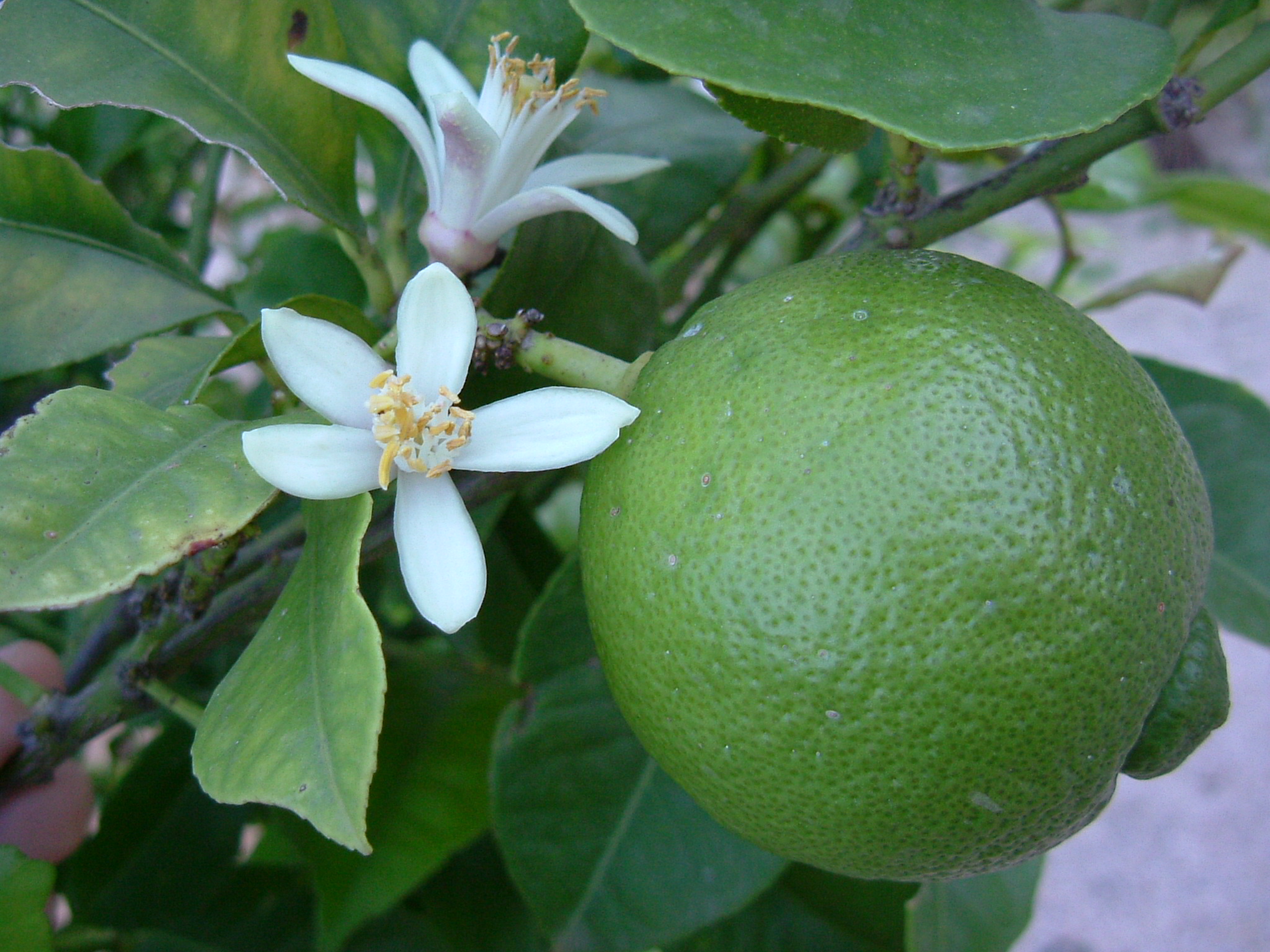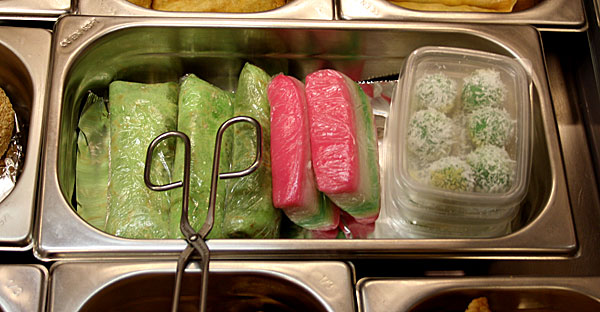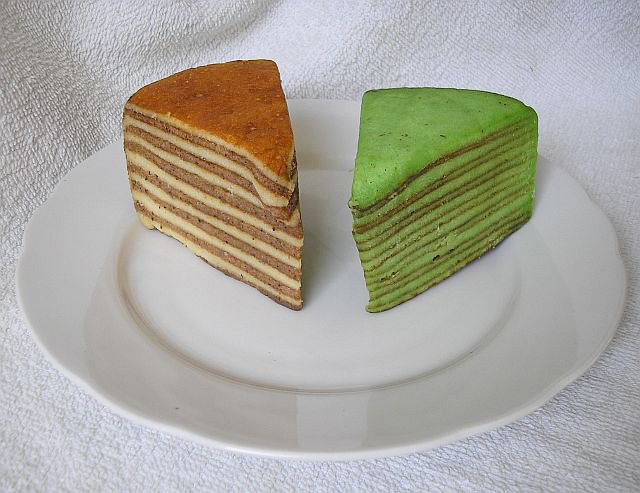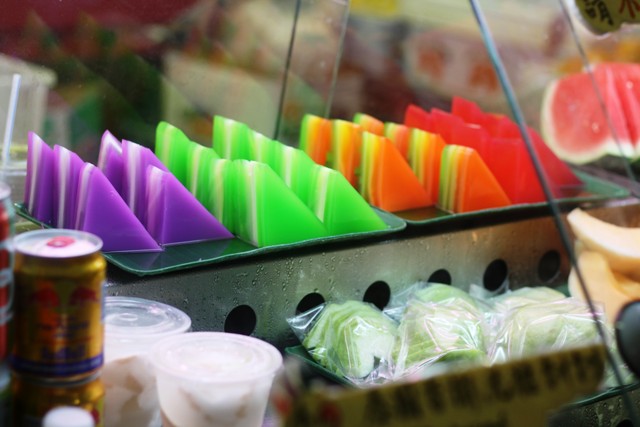|
Lupis (food)
Lupis (sometimes lopis) is an Indonesian traditional sweet cake made of glutinous rice, banana leaves, coconut, and brown sugar sauce. Lupis is one of many glutinous rice desserts from Indonesia. Lupis are sometimes cylindrically shaped like Lontong, or shaped like a triangle. Lupis is usually eaten with thick palm sugar syrup and with shredded coconut toppings. Often eaten at breakfast or as a side dish during the evening, lupis is often sold at traditional marketplaces throughout Indonesia and is a popular food found nationwide, but especially in middle and eastern Java as well as West Sumatra. Lupis is one of the top desserts that tourists who visit Purwokerto in Java seek. Cooking method Lupis is made by first soaking glutinous rice in water, salt, and lime juice. After draining the water, the soaked glutinous rice is moved onto banana leaves in single-serving-size portions to be wrapped for shaping. The wrapped rice triangles are then put aside for the creation of the syrup ... [...More Info...] [...Related Items...] OR: [Wikipedia] [Google] [Baidu] |
Indonesia
Indonesia, officially the Republic of Indonesia, is a country in Southeast Asia and Oceania, between the Indian Ocean, Indian and Pacific Ocean, Pacific oceans. Comprising over List of islands of Indonesia, 17,000 islands, including Sumatra, Java, Sulawesi, and parts of Borneo and New Guinea, Indonesia is the world's largest archipelagic state and the List of countries and dependencies by area, 14th-largest country by area, at . With over 280 million people, Indonesia is the world's List of countries and dependencies by population, fourth-most-populous country and the most populous Islam by country, Muslim-majority country. Java, the world's List of islands by population, most populous island, is home to more than half of the country's population. Indonesia operates as a Presidential system, presidential republic with an elected People's Consultative Assembly, legislature and consists of Provinces of Indonesia, 38 provinces, nine of which have Autonomous administrative divisi ... [...More Info...] [...Related Items...] OR: [Wikipedia] [Google] [Baidu] |
Lime (fruit)
A lime is a citrus fruit, which is typically round, lime (color), lime green in colour, in diameter, and contains acidic juice vesicles. There are several species of citrus trees whose fruits are called limes, including the Key lime (''Citrus aurantiifolia''), Persian lime, kaffir lime, finger lime, blood lime, and Citrus glauca, desert lime. Limes are a rich source of vitamin C, are sour, and are often used to accent the flavours of foods and beverages. They are grown year-round. Plants with fruit called "limes" have diverse genetic origins; limes do not form a monophyletic group. The term ''lime'' originated in other languages (from French language, French , from Arabic , from Persian language, Persian , ). Plants known as "lime" The difficulty in identifying exactly which species of fruit are called lime in different parts of the English-speaking world (the same problem applies to synonyms in other European languages) is increased by the botanical complexity of the ''Citru ... [...More Info...] [...Related Items...] OR: [Wikipedia] [Google] [Baidu] |
Vegetarian Dishes Of Indonesia
Vegetarianism is the practice of abstaining from the consumption of meat (red meat, poultry, seafood, insects, and the flesh of any other animal). It may also include abstaining from eating all by-products of animal slaughter. A person who practices vegetarianism is known as a vegetarian. Vegetarianism may be adopted for various reasons. Many people object to eating meat out of respect for sentient animal life. Such ethical motivations have been codified under various religious beliefs as well as animal rights advocacy. Other motivations for vegetarianism are health-related, political, environmental, cultural, aesthetic, economic, taste-related, or relate to other personal preferences. A small number of towns and cities around the world are exclusively vegetarian or have outlawed meat, including Rishikesh, which banned meat, fish, and eggs in 1956. A larger number of towns and cities are vegetarian-friendly. In other locations, finding vegetarian food can pose some diff ... [...More Info...] [...Related Items...] OR: [Wikipedia] [Google] [Baidu] |
Indonesian Desserts
This is a list of Indonesian desserts. In Indonesia, desserts are called as ''pencuci mulut'' or ''hidangan penutup''. The style of cooking and foods in Indonesian cuisine—including desserts—are local cuisine with Arabs, Chinese, Indian, and European (especially Dutch, Portuguese, and Spanish) cuisine influences, adapted to local tastes, local palates and indigenous ingredients. Indonesian desserts are very diverse and rich. A B C D E G K L M N O P R S T V W See also *Cuisine of Indonesia *Dessert *Kue *List of desserts *List of Indonesian beverages *List of Indonesian dishes *List of Indonesian snacks *List of Indonesian soups *Street food of Indonesia References External links Eating the Indonesian wayIndonesian RecipesGood Indonesian Heritage Food and Cuisine {{DEFAULTSORT:Indonesian Dishes, List Of Indonesian cuisine, * Indonesian desserts, * Dessert-related lists, Indonesia Indonesian cuisine-related lists, Deserts ... [...More Info...] [...Related Items...] OR: [Wikipedia] [Google] [Baidu] |
Indonesian Rice Dishes
Indonesian is anything of, from, or related to Indonesia, an archipelagic country in Southeast Asia. It may refer to: * Indonesians, citizens of Indonesia ** Native Indonesians, diverse groups of local inhabitants of the archipelago ** Indonesian women, overview of women's history and contemporary situations * Indonesian language (Indonesian: ''Bahasa Indonesia''), the official language of Indonesia ** Indonesian languages, overview of some of the 700 languages spoken in Indonesia ** Indonesian names, customs reflecting the multicultural and polyglot nature of Indonesia * Indonesian culture, a complex of indigenous customs and foreign influences ** Indonesian art, various artistic expressions and artworks in the archipelago ** Indonesian cinema, a struggling and developing industry ** Indonesian literature, literature from Indonesia and Southeast Asia with shared language roots ** Indonesian music, hundreds of forms of traditional and contemporary music ** Indonesian philosoph ... [...More Info...] [...Related Items...] OR: [Wikipedia] [Google] [Baidu] |
Seri Muka
Kuih seri muka ( Jawi: ) , sri muka or putri salat () is a Banjarese and Malay two-layered dessert with steamed glutinous rice forming the bottom half and a green custard layer made with pandan juice (hence the green colour). Coconut milk is a key ingredient in making this ''kue''. It is used to impart creamy taste when cooking the glutinous rice and making the custard layer. This kue is found in Indonesia (especially in South Kalimantan), Malaysia and Singapore. In 2009, the Malaysian Department of National Heritage declared seri muka as one of 100 Malaysian heritage foods and drinks. The Star Online See also * * |
Lapis Legit
Lapis legit, also known as spekkoek (; or ), is a type of Indonesian layer cake. It was developed during colonial times in the Dutch East Indies. The firm-textured cake is an Indo (Dutch-Indonesian) version of the multi-layered rice cakes that are usually seen in Southeast Asian desserts but using some Dutch ingredients like flour and butter. It contains a mix of Indonesian spices, such as cardamom, cinnamon, clove, mace and anise. The cake is made of flour and yolk and is rich in butter or margarine. Lapis legit is popular in Indonesia and is served as a holiday treat, especially for '' natal'', '' imlek'', and '' lebaran''. It is also served or given as gifts during many local festivities such as at birthday parties and weddings. In the Netherlands, the sliced cake can be found in most grocery stores and Asian markets ( tokos). It is traditionally served for dessert in rijsttafel. It is also a very popular dessert in Hadhramout. Etymology The Dutch term spekkoek trans ... [...More Info...] [...Related Items...] OR: [Wikipedia] [Google] [Baidu] |
Kue Lapis
Kue lapis () , also known as kuih lapis ( or ) (Indonesian language, Indonesian and Malay language, Malay respectively for "layered cake") is a traditional Southeast Asian steamed dessert known for its colourful, multi-layered appearance and soft, chewy texture. It is commonly found in Indonesia, Malaysia, Singapore and Brunei, and is particularly associated with Peranakan Chinese, Peranakan cuisine. Due to historical Javanese Surinamese, migration and Indo people, colonial ties, the dessert is also popular in Suriname, where it is known simply as ''lapis'', as well as in the Netherlands. The dish is believed to have originated from Overseas Chinese, Chinese immigrants, especially those from southern China, who introduced steamed rice cakes such as ''jiu ceng gao'' (九层糕, "nine layer cake") to the region. Over time, the recipe was adapted with local ingredients such as coconut milk, Pandanus tectorius, pandan and tapioca flour, resulting in the distinctively Southeast Asia, ... [...More Info...] [...Related Items...] OR: [Wikipedia] [Google] [Baidu] |
Coconut Sugar
Coconut sugar (also known as coco sugar, coconut palm sugar, coco sap sugar or coconut blossom sugar) is a palm sugar produced from the sap of the flower bud stem of the coconut palm. Other types of palm sugar are made from the kithul palm ('' Caryota urens''), Palmyra palm, the date palm, the sugar date palm, the sago palm or the sugar palm. Used as a sweetener in many countries, coconut sugar has no significant nutritional or health benefits over other sweeteners. Manufacture Coconut sugar comes in crystal or granule form, block or liquid. Producing coconut sugar is a two-step process. It starts with harvesting or "tapping" nectar from the flower bud stem of a coconut tree. Farmers make a cut on the spadix and the sap starts to flow from the cut into bamboo containers. The sap collected is then transferred into large woks and placed over moderate heat to evaporate the moisture content of the sap. The sap is translucent and is about 80% water. At this point it is known as ... [...More Info...] [...Related Items...] OR: [Wikipedia] [Google] [Baidu] |
Salt
In common usage, salt is a mineral composed primarily of sodium chloride (NaCl). When used in food, especially in granulated form, it is more formally called table salt. In the form of a natural crystalline mineral, salt is also known as rock salt or halite. Salt is essential for life in general (being the source of the essential dietary minerals sodium and chlorine), and saltiness is one of the basic human tastes. Salt is one of the oldest and most ubiquitous food seasonings, and is known to uniformly improve the taste perception of food. Salting, brining, and pickling are ancient and important methods of food preservation. Some of the earliest evidence of salt processing dates to around 6000 BC, when people living in the area of present-day Romania boiled spring water to extract salts; a salt works in China dates to approximately the same period. Salt was prized by the ancient Hebrews, Greeks, Romans, Byzantines, Hittites, Egyptians, and Indians. Salt became a ... [...More Info...] [...Related Items...] OR: [Wikipedia] [Google] [Baidu] |
Glutinous Rice
Domestication syndrome refers to two sets of phenotypic traits that are common to either domesticated plants or domesticated animals. Domesticated animals tend to be smaller and less aggressive than their wild counterparts; they may also have floppy ears, variations to coat color, a smaller brain, and a shorter muzzle. Other traits may include changes in the endocrine system and an extended breeding cycle. These animal traits have been claimed to emerge across the different species in response to selection for tameness, which was purportedly demonstrated in a famous Russian fox breeding experiment, though this claim has been disputed. Other research suggested that pleiotropic change in neural crest cell regulating genes was the common cause of shared traits seen in many domesticated animal species. However, several recent publications have either questioned this neural crest cell explanation or cast doubt on the existence of domestication syndrome itself. One recent publica ... [...More Info...] [...Related Items...] OR: [Wikipedia] [Google] [Baidu] |
Purwokerto
Purwokerto () is a large but non-autonomous town on the island of Java, Indonesia. It is the coordinating centre of local government (''Bakorwil 3'') and the largest city in southwestern Central Java (known as the ''Barlingmascakeb'' region). Currently, Purwokerto is the capital of Banyumas Regency, Central Java province. The population of the four districts which comprise the town at the 2010 census was 233,951 and 229,271 at the 2020 census; the official estimate as of mid-2024 was 236,162.Badan Pusat Statistik, Jakarta, 28 February 2025, ''Kabupaten Banyumas Dalam Angka 2025'' (Katalog-BPS 1102001.3302) The built-up area of Purwokerto extends beyond these four administrative districts into parts of surrounding districts, and has a metropolitan area population of 416,964 at the 1990 Census. Geography Purwokerto is located in the middle of Java Island within the province of Central Java, near the base of Mount Slamet, the second-tallest mountain in Java. The average eleva ... [...More Info...] [...Related Items...] OR: [Wikipedia] [Google] [Baidu] |








